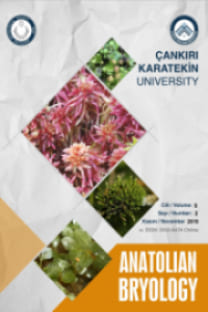Ankara’nın Beypazarı, Güdül ve Nallıhan İlçelerinden Toplanan Bazı Karayosunlarının Antimikrobiyal ve Antifungal Aktiviteleri
Bu çalışmada, daha önce çalışılmamış beş farklı karayosunu türü (Gymnostomum aeruginosum Sm., Grimmia montana Bruch & Schimp, Ptychostomum pseudotriquetrum (Hedw.) J.R.Spence & H.P.Ramsay, Hygroamblystegium humile (P.Beauv.) Vanderp. & Hedenäs, Brachythecium rivulare Schimp.) potansiyel antimikrobiyal ve antifungal özelliklerini araştırmak amacıyla Ankara'nın kuzey-batı ilçelerinden (Beypazarı, Güdül, Nallıhan) toplanmıştır. Bu araştırmada disk difüzyon (DD) ve agar well difüzyon (AWD) yöntemleri kullanılarak metanol, etanol, aseton ve kloroform çözücüleri ile elde edilen karayosunu ekstraktlarının bir mantar olan Candida albicans ATCC 10231, gram-negatif bir bakteri olan Escherichia coli ATCC 35218 ve gram-pozitif bir bakteri olan Staphylococcus aureus ATCC 25923 suşları üzerindeki antimikrobiyal ve antifungal etkileri araştırılmıştır. Karayosunu özütleri test edilen tüm mikroorganizmalara karşı antimikrobiyal özellikler göstermiş olup, inhibisyon bölgeleri bakteriler için 7,0 ila 14,0 mm ve maya için 8,0 ila 13,0 mm arasında değişmektedir. Elde edilen sonuçlara göre, Staphylococcus aureus ATCC 25923 suşu, beş farklı karayosunu türünden elde edilen çeşitli ekstraktlardan en çok etkilenen mikroorganizma olarak bulunmuştur. Bununla birlikte, bu araştırmanın önemli bir bulgusu, Grimmia montana Bruch & Schimp ve Gymnostomum aeruginosum’un antimikrobiyal ve antifungal özellikleri bakımından incelenen diğer karayosunu türlerinden daha etkili olduğudur. Ayrıca, her iki karayosunu türü de ilgili alanlarda daha ileri araştırmalar yapmak için umut verici bir potansiyel sunmaktadır.
Anahtar Kelimeler:
Antimikrobiyal, antifungal, karayosunu, Ankara
Antimicrobial and Antifungal Activities of Some Mosses Collected from Beypazarı, Güdül and Nallıhan Districts of Ankara
In this study, five previously unstudied different mosses (Gymnostomum aeruginosum Sm., Grimmia montana Bruch & Schimp., Ptychostomum pseudotriquetrum (Hedw.) J.R.Spence & H.P.Ramsay, Hygroamblystegium humile (P.Beauv.) Vanderp. & Hedenäs, Brachythecium rivulare Schimp.) were gathered from the north-west districts of Ankara (Beypazarı, Güdül, Nallıhan) in order to investigate their potential antimicrobial and antifungal properties. In this research, the antimicrobial activities of moss samples were examined by using the disc diffusion (DD) and agar well diffusion (AWD) methods. This study investigated the antimicrobial and antifungal effects of moss extracts which were obtained through methyl alcohol, ethyl alcohol, acetone, and chloroform solvents on Candida albicans ATCC 10231 (fungus), Escherichia coli ATCC 35218 (gram-negative bacterium), and Staphylococcus aureus ATCC 25923 (gram-positive bacterium) using the disc diffusion (DD), agar well diffusion (AWD) and minimum inhibitory concentration (MIC) methods. The moss extracts have demonstrated antimicrobial properties against all microorganisms tested, with inhibition zones ranging from 7.0 to 14.0 mm for bacteria and 8.0 to 13.0 mm for yeast. Based on the results, the Staphylococcus aureus ATCC 25923 strain was the microorganism most affected by several extracts from five different moss species. Furthermore, a significant finding of this research is that Grimmia montana Bruch & Schimp and Gymnostomum aeruginosum are more efficient than other studied moss species concerning their antimicrobial and antifungal properties. Additionally, both moss species present promising potential for further research in related areas.
Keywords:
Antimicrobial, antifungal, moss, Ankara,
___
- Altuner E.M. Canlı K. Akata I. 2014a. Antimicrobial Screening of Calliergonella cuspidata, Dicranum polysetum and Hypnum cupressiforme. Journal of Pure and Applied Microbiology. 8:1, 539-545.
- Altuner E.M. Canlı K. Akata I. 2014b. In vitro Antimicrobial Screening of Hedwigia ciliata var. leucophaea and Determination of the Ethanol Extract Composition by Gas Chromatography/Mass Spectrometry (GC/MS). Journal of Pure and Applied Microbiology. 4:8, 2987-2998.
- Andrews J. M. 2001. Determination of Minimum Inhibitory Concentrations. Journal of Antimicrobial Chemotherapy. 48:1, 5-16.
- Andrews J.M. 2003. BSAC standardized disc susceptibility testing method (version 6). Journal of Antimicrobial Chemotherapy. 60, 20-41.
- Benek A. Canlı K. Altuner E.M. 2022. Traditional Medicinal Uses of Mosses. Anatolian Bryology. 8:1, 57-65.
- Benek A. Canlı K. Altuner E. M. 2023. Antimicrobial and Antioxidant Activities of Some Mosses. Anatolian Bryology. 9:1, 42-49.
- Canlı K. Yetgin A. Akata I. Altuner E.M. 2016. In vitro Antimicrobial Screening of Aquilaria agallocha Roots. African Journal of Traditional, Complementary and Alternative medicines. 13:5, 178-181.
- Çolak E. Kara R. Ezer T. Yuvalı Çelik G. Elibol B. 2011. Investigation of Antimicrobial Activity of Some Turkish Pleurocarpic Mosses. African Journal of Biotechnology. 10:60, 12905-12908.
- Harris E.S. 2008. Ethnobryology: traditional uses and folk classification of bryophytes. The Bryologist. 111:2, 169-217.
- Okan O.T. 2023. Antioxidant, antimicrobial and some chemical composition of Plagiochila asplenioides (L.) Dumort extract. Anatolian Bryology. 9:1, 11-19. Sümerkan B. Gökahmetoğlu S. 1998. MIC, MBC Testleri, Rutindeki Önemi ve Uygulamaları. Flora. 3:2, 91-95.
- Thieret J.W. 1956. Bryophytes as Economic Plants in Economic Botany. Springer on behalf of New York Botanical Garden Press. 10:1, 75-91.
- Tonguç Yayıntaş Ö. Yılmaz S. Sökmen M. 2019. Determination of Antioxidant, Antimicrobial and Antitumor Activity of Bryophytes from Mount Ida (Canakkale, Turkey) . Indian Journal of Traditional Knowledge. 18:2, 395-401.
- Yetgin A. Şenturan M. Benek A. Efe E. Canlı A. 2017. Determination of Pterigynandrum filiforme Hedw. Antimicrobial Activity. Anatolian Bryology. 3:1, 43-47
- Uyar G. Hacıoğlu Doğru N. Ören M. Çavuş A. 2016. Determining Antibacterial Activity of Some Mosses (Cinclidotus riparius (Host ex Brid.) Arn., Calliergonella cuspidata (Hedw.) Loeske, Thamnobryum alopecurum (Hedw.) Gangulee, Leucobryum juniperoideum (Brid.) Müll.Hal., Cirriphyllum crassinervium (Taylor) Loeske & M.Fleisch.). Anatolian Bryology. 1-2 (2): 1-8.
- Uyar G. Demir N. Hacıoğlu Doğru N. 2023. Dichodontium pellucidum (Hedw.) Schimp. Karayosununun Antimikrobiyal, Antibiyofilm ve Antioksidan Aktivitelerinin Araştırılması. Türk Tarım ve Doğa Bilimleri Dergisi. 10:3, 548-555.
- ISSN: 2149-5920
- Yayın Aralığı: Yılda 2 Sayı
- Başlangıç: 2015
- Yayıncı: Çankırı Karatekin Üniversitesi
Sayıdaki Diğer Makaleler
Gülen Nur HAŞİMOĞLU, Güray UYAR, Nazife ASLAN, Gülden VURAL
Soğanlı Vadisi (Kayseri) Karayosunu Florası
Recep KARA, Cemal SEVİNÇ, Emrah URLU
Türkiye’deki Hookeria (Hookeriaceae) Türleri Üzerine Notlar
Tülay AŞKIN ÇELİK, Özlem Sultan ASLANTÜRK, Gözde ASLAN, Mesut KIRMACI
İzmir İli Ciğerotu (Marchantiophyta= Hepaticae) Florasına Katkılar (Türkiye)
Türkiye’deki Küçük Pleurokarp Yapraklı Karayosunu Platydictya jungermannioides (Brid.) H.A.Crum
Tülay EZER, Ali KESKİN, Ahmet UYGUR, Harun ÇULHA, Züleyha ASLAN, Nevzat BATAN, Mevlüt ALATAŞ
Türkiye’deki Amphidium (Amphidiaceae) Türleri Üzerine Notlar
